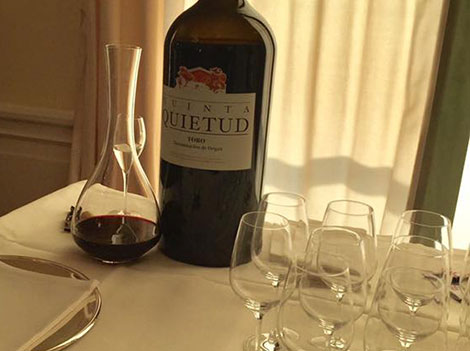

 Quinta Quietud from Toro, a Spanish wine offered by the glass at three-starred restaurant La Table in Hamburg.
Quinta Quietud from Toro, a Spanish wine offered by the glass at three-starred restaurant La Table in Hamburg.
Germany is Europe’s second Michelin-starred country only behind France. Out of 292 restaurants carrying this distinction, 243 boast one star; 39 have two stars and 10 have been awarded the precious three stars. Germany’s fine cuisine is particularly well represented in the country’s wealthiest regions: Bavaria, Baden-Wurtemberg and North Rhine-Westphalia where classic, French-style restaurants are the norm. Accordingly, most wine lists are dominated by France while German wines lead the way in the country’s most famous wine regions: Mosel and Baden.
Spanish wines usually come third or fourth, just behind or ahead of Italy and Austria. International recognition of Spain’s cuisine led by Ferran Adrià and the emergence of specialist Spanish distributors have helped to enhance the presence of Spain in wine lists.
A good example is Schwarzwaldstube restaurant in Baiersbronn. It was awarded three Michelin stars in 1992 and its chef Harald Wohlfahrt has announced his retirement this year. Among the 700 wines on offer, Spain is well represented with Rueda, Ribera del Duero and lesser-known regions like Méntrida and Ribeira Sacra. Bareiss, another three-starred classic located in Baiersbronn in the Black Forest region, lists next to old Bordeaux vintages a Vega Sicilia Único 1936 at €2,000.
In big cities like Berlin or Hamburg where food culture is not as deeply-rooted as in southern areas of the country, modern, avant-garde restaurants are becoming more common. The so called “casual fine dining” is the new trend: haute cuisine served in a relaxed atmosphere without tablecloths on the tables and waiters not wearing suits. It’s perfect to attract younger consumers who may be reluctant to go to a traditional, formal restaurant.
Tim Raue’s two-starred Asian restaurant in Berlin and Kevin Fehling’s La Table (3 stars) in Hamburg are two good examples. Decorated with high ceilings and concrete walls, diners sit at cherry-wood high tables facing the kitchen just across the bar counter. Despite listing only 10 Spanish wines within its 140 brands, sommelier David Eitel often includes Spanish wines in the menu choice. Over the past few months for instance he has offered by the glass Roda from Rioja, Valsotillo from Ribera del Duero and Quinta Quietud, an organic red Toro. According to Eitel, wine lists are losing prominence as 90% of the clients choose to pair their menus with recommended wines by the glass.
Environmental concerns and healthy leaving, which are particularly important in Germany, have brought the emergence of vegetarian and vegan menus in Michelin-starred restaurants. Suggestions to pair with them include soft drinks such as mandarin juice with cardamom seed extract or Ayurveda tea with licorice, fennel and mint. Noma restaurant in Copenhagen pioneered the trend, but German chef Nils Henkel, who once held three and two Michelin-stars and joined Burg Schwarzenstein restaurant in Geisenheim-Johannisberg in February this year, started offering this alternative with his tasting menus in 2012: “It is really appreciated, particularly at noon,” he says.
There are many reasons behind the clients’ decision to avoid alcohol (religion, health or just because they have to drive or go back to work), but many of them don’t want to miss the chance of enjoying the art of matching food and wine.
In line with this trend, many sommeliers are increasingly interested in organic and natural wines to match vegan menus and prove a discovery for their clients. According to David Eitel, the most important thing is that guests enjoy the wines. “Most of them don’t really know what and orange wine or a natural wine is”, he explains. At his three-starred restaurant in Hamburg he pours lots of biodynamic wines because many leading producers have adopted this philosophy, yet all of them have to pass his tasting standards.
“Large wine lists resembling a phone directory are out of date”, says Marco Antonio Aguado from Ravenborg Pan y Vino, a Spanish specialist merchant based near Hamburg. “Top restaurants are increasingly offering wine pairings with their tasting menus”. Even if all restaurants have a wine list, sommeliers like to serve specific wines with specific dishes. As tasting menus tend to have many dishes with varied ingredients, using different wines to pair with them makes it easier. In this way sommeliers also have the freedom to make changes depending on the menus or seasons.
Despite listing over 800 wines, Marco Franzelin, sommelier at three-starred Vendôme in Bergisch Gladbach, told us that 80% of their clients choose the option by the glass. This allows him to combine classic wine regions and brands like red Tondonia Reserva from Rioja with off-the-beaten-track brands like Nana Albariño from Bodegas Attis in Rías Baixas.
Generally speaking, the average price for a menu at a three-starred restaurant in Germany is about €200 with €100 for wine pairings.
Even if Spanish wines are not too visible in Germany’s top restaurants, they have increased their presence over the last few years and today it is rare to see a Michelin-starred restaurant without Spanish wines on its menu. Styles have changed though: even if sommeliers still look for wines made from local varieties, whites are gaining popularity for their food-matching ability.
Marcel Runge, sommelier at Aqua restaurant (3 stars) in Wolfsburg lists 800 different wines with a special focus on Germany, Austria, France and Spain. In terms of pairings he tries to find a balance between well-known producers and more obscure wines. Among the latter, some white favourites are Vidonia Listán Blanco, made by Suertes del Marqués in Tenerife (Canary Islands) or Albillo-based wines from Vinos de Madrid.
According to Daniel Varela, from Spanish specialist Viniberica, senior, highly experienced sommeliers are faithful to classic Spanish regions like Jerez, Rioja or Ribera del Duero, but the younger generations usually include wines from lesser-known regions, providing that they are distinctive, pair well and have a good story behind.